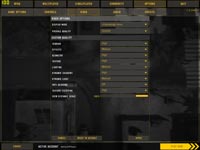
Battlefield 2
Publisher: Electronic ArtsWe are using the newly released follow up to Battlefield 1942 and Battlefield: Vietnam, Battlefield 2. It features an all-new game engine based on the DirectX 9.0 API. There is no Shader Model 3.0 support, but the majority of hardware will use a Shader Model 2.0++ mode that includes support for Normal Maps, Parallax Mapping, Full-Resolution Dynamic Shadowing, Post Processing and Fog.
The game will look the same on both NVIDIA and ATI hardware, so there is no advantage of choosing one over the other in image quality related circumstances. The only major difference is that Ultra Shadow 2 is utilised on NVIDIA's hardware, while the Shadowing on ATI hardware is done using a slightly different technique.
We played five five-minute segments of the same map, taking the median frame rate as our published frame rates. We found that there was no 100% repeatable way to benchmark this game manually, so we felt that taking a typical slice of action from the game was the best way to report our findings. We controlled Anti-Aliasing from inside the game, while Anisotropic Filtering was controlled from the driver control panel.
We found that the GeForce 7800 GTX SLI was able to deliver a smooth gaming experience at 1600x1200 4xAA 8xAF with most in-game details set to 'High'. The exceptions to this were Effects Quality and Lighting, which were set to 'Medium' in order to give us an enjoyable hitch-free experience.
With a single GeForce 7800 GTX, we found that we could play the game with the same in-game detail settings, only lowering Anti-Aliasing to 2x in order to remove all of the hitching that we experienced when using 4xAA. That meant we were able to play the game at 1600x1200 2xAA 8xAF with 'High' in-game details on a single 7800 GTX.
The GeForce 6800 Ultra SLI delivered a completely playable frame rate at 1280x960 2xAA 8xAF with 'High' in-game details, as set on the GeForce 7800 series video cards in this title – Effects and Lighting were set to Medium to remove the hitching that we experienced with those settings turned on.
A single 6800 Ultra was playable with a Medium-High in-game detail setting at 1280x960 0xAA 8xAF. We were able to set Terrain, Texture and Texture Filtering to 'High', while all other in-game details were set to 'Medium'.
Finally, our Radeon X850 XT Platinum Edition attained completely playable frame rates at 1280x960 0xAA 8xAF with Medium-High in-game details. Terrain, Geometry, Texture, Dynamic Shadows and Texture Filtering were all set to 'High'.

Also, GeForce 7800 GTX scaled pretty well in SLI and we didn't find that the CPU we had chosen to evaluate GeForce 7800 GTX with was limiting the performance attainable by GeForce 7800 GTX in SLI. We found that we were able to increase the Anti-Aliasing samples at the same time as increasing our frame rate.
In terms of the previous generation of video cards, the Radeon X850 XT Platinum Edition was the top performer in a single video card configuration. However, SLI scales pretty well in this title, so dual GeForce 6800 Ultra allowed for higher performance still.

MSI MPG Velox 100R Chassis Review
October 14 2021 | 15:04






Want to comment? Please log in.